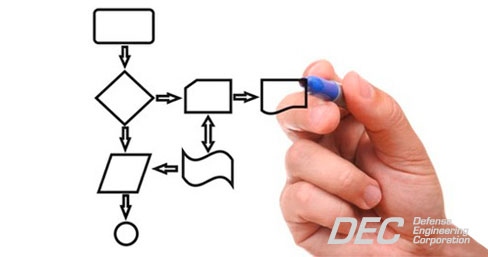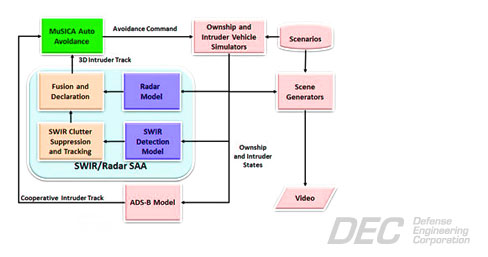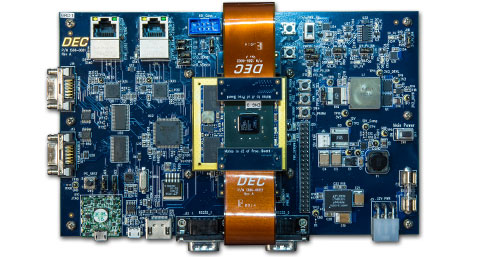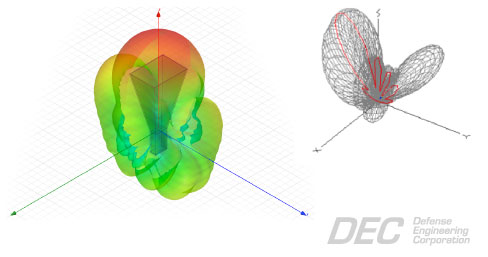System Engineering
 DEC is familiar with the systems engineering process and applying it in the context of developing and transitioning military capability. Most importantly, DEC understands how to tailor the process based on the scope of the project. Consider designing a prototype for research experiments versus designing one for an Engineering and Manufacturing Development (EMD) program. Both require intelligent and systematic application of the systems engineering process. DEC’s expertise lies in tailoring the process to obtain good results for the laboratory prototype by applying the core principles informally to efficiently demonstrate technology feasibility while meeting tight budget/schedule constraints. Similarly, DEC applies the process with formality and rigor in order to produce design verification artifacts needed for transition and eventual certification.
DEC is familiar with the systems engineering process and applying it in the context of developing and transitioning military capability. Most importantly, DEC understands how to tailor the process based on the scope of the project. Consider designing a prototype for research experiments versus designing one for an Engineering and Manufacturing Development (EMD) program. Both require intelligent and systematic application of the systems engineering process. DEC’s expertise lies in tailoring the process to obtain good results for the laboratory prototype by applying the core principles informally to efficiently demonstrate technology feasibility while meeting tight budget/schedule constraints. Similarly, DEC applies the process with formality and rigor in order to produce design verification artifacts needed for transition and eventual certification.
Software Engineering
 DEC develops software for embedded systems as well as non-real-time applications. DEC’s software engineers developed command and control software for a custom FPGA board implementing a software-defined scanning radio receiver for intelligence gathering applications. The software provides an external network interface for user interaction as well as expandability through a plug-in interface to the software. DEC also developed real-time embedded software and firmware for Sense and Avoid system prototypes. DEC developed graphical applications for displaying video and controlling a custom video data acquisition and recording equipment along with extensive test data analysis/visualization tools written in Matlab.
DEC develops software for embedded systems as well as non-real-time applications. DEC’s software engineers developed command and control software for a custom FPGA board implementing a software-defined scanning radio receiver for intelligence gathering applications. The software provides an external network interface for user interaction as well as expandability through a plug-in interface to the software. DEC also developed real-time embedded software and firmware for Sense and Avoid system prototypes. DEC developed graphical applications for displaying video and controlling a custom video data acquisition and recording equipment along with extensive test data analysis/visualization tools written in Matlab.
Modeling & Simulation
 One of DEC’s core technical services is in Modeling and Simulation of phenoma and systems. DEC’s technical staff utilize tools such as Matlab, Simulink, and AMASE in the modeling of processes and data generation for testing simulated processes or models. Current DEC project is using modeling and simulation in the determination of reliable operating ranges for their tracker solutions for use on UAVs (Unmanned Aerial Vehicles). AMASE is used to provide various flight scenarios that generate position data to feed into the tracker. The tracker is tested with realistic data to validate system performance. Matlab is used to test algorithms during the design and development stages of a project to identify any weakness in the process. Once the technical staff is satified with the algorithms performance, converting the Matlab script to code to be used in the project is a simple and quick process using Matlab’s array of tools.
One of DEC’s core technical services is in Modeling and Simulation of phenoma and systems. DEC’s technical staff utilize tools such as Matlab, Simulink, and AMASE in the modeling of processes and data generation for testing simulated processes or models. Current DEC project is using modeling and simulation in the determination of reliable operating ranges for their tracker solutions for use on UAVs (Unmanned Aerial Vehicles). AMASE is used to provide various flight scenarios that generate position data to feed into the tracker. The tracker is tested with realistic data to validate system performance. Matlab is used to test algorithms during the design and development stages of a project to identify any weakness in the process. Once the technical staff is satified with the algorithms performance, converting the Matlab script to code to be used in the project is a simple and quick process using Matlab’s array of tools.
Flight Testing
 DEC routinely performs flight testing of prototype sensor systems developed in-house or by collaborators. This includes flight test planning, aircraft modification, equipment installation, test execution, and test documentation. DEC has executed flight tests involving multiple aircraft, surrogate threat missiles, developmental sensors for self-protection, collision avoidance, and cruise missile guidance. DEC is familiar with the DoD approval process for flight testing including Technical Review Boards and Safety Review Boards.
DEC routinely performs flight testing of prototype sensor systems developed in-house or by collaborators. This includes flight test planning, aircraft modification, equipment installation, test execution, and test documentation. DEC has executed flight tests involving multiple aircraft, surrogate threat missiles, developmental sensors for self-protection, collision avoidance, and cruise missile guidance. DEC is familiar with the DoD approval process for flight testing including Technical Review Boards and Safety Review Boards.
Algorithm Development
 DEC is currently developing image processing, object tracking, and digital filtering algorithms for radar and EO/IR sensor systems. These algorithms are typically developed in the MATLAB environment and implemented in real-time systems through the use of MATLAB’s automatic code generation capabilities. This allows DEC to rapidly go from algorithm design to prototype without inducing errors from re-coding.
DEC is currently developing image processing, object tracking, and digital filtering algorithms for radar and EO/IR sensor systems. These algorithms are typically developed in the MATLAB environment and implemented in real-time systems through the use of MATLAB’s automatic code generation capabilities. This allows DEC to rapidly go from algorithm design to prototype without inducing errors from re-coding.
Hardware Development
 DEC technical staff has expertise in various aspects of hardware development including enclosure design, printed circuit board design, and FPGA development. DEC primarily uses Xilinx technologies, such as Virtex and Zynq platforms, for firmware development. DEC uses VHDL to implement algorithms in FPGAs. DEC also uses a Matlab-to-VHDL desgin flow to reduce development time and aide in cross platform verification. DEC also uses Matlab to augment the firmware simulations done using industry leading simulation tools. DEC has experience developing boards starting with the circuit design and schematics, through PCB layout, and working with PCB fabrication houses to ensure the highest quality product is delivered to the customer within the estimated time.
DEC technical staff has expertise in various aspects of hardware development including enclosure design, printed circuit board design, and FPGA development. DEC primarily uses Xilinx technologies, such as Virtex and Zynq platforms, for firmware development. DEC uses VHDL to implement algorithms in FPGAs. DEC also uses a Matlab-to-VHDL desgin flow to reduce development time and aide in cross platform verification. DEC also uses Matlab to augment the firmware simulations done using industry leading simulation tools. DEC has experience developing boards starting with the circuit design and schematics, through PCB layout, and working with PCB fabrication houses to ensure the highest quality product is delivered to the customer within the estimated time.
Antenna Design, Fabrication, and Evaluation
 DEC has extensive experience designing, testing, and evaluating antennas, phased arrays and their RF back ends for military applications from VHF through Ka Bands. DEC’s capability begins with antenna simulation and optimization using state of the art electromagnetic software tools, through prototype builds, and into anechoic chamber testing and verification. DEC experience ranges from electrically small antennas through high power phased array systems. DEC can provide new designs, evaluation and optimization of previous efforts and prototype hardware for all of your antennas and sensor’s demanding requirements.
DEC has extensive experience designing, testing, and evaluating antennas, phased arrays and their RF back ends for military applications from VHF through Ka Bands. DEC’s capability begins with antenna simulation and optimization using state of the art electromagnetic software tools, through prototype builds, and into anechoic chamber testing and verification. DEC experience ranges from electrically small antennas through high power phased array systems. DEC can provide new designs, evaluation and optimization of previous efforts and prototype hardware for all of your antennas and sensor’s demanding requirements.
CAD Design
 DEC offers a wide range of CAD services in 2D & 3D Modeling. Armed with the latest tools, DEC’s skilled design professionals give deliver quick turnaround times and high accuracy. Example applications include:
DEC offers a wide range of CAD services in 2D & 3D Modeling. Armed with the latest tools, DEC’s skilled design professionals give deliver quick turnaround times and high accuracy. Example applications include:
- 3D CAD models for rapid prototyping of new products
- Advanced surface models for CAE analysis
- Gage and fixture design to support component manufacturing
If you need to know more, DEC works with third parties to conduct thermal, structural, CFD, and/or electromagnetic analyses based on 3D models. If a model isn’t enough, DEC will 3D print parts using the latest additive manufacturing techniques. Alternatively, DEC will produce 2D mechanical drawings for traditional manufacturing techniques. Contact us today and see how our experienced team can help overcome your design challenges.
AFRL Outdoor Radar Test Range
DEC engineers and technicians conduct research and development of advanced sensor systems at the Air Force Research Laboratory Sensors Directorate at Wright Patterson AFB OH.
Sense and Avoid (SAA)
DEC has extensive expertise in Sense And Avoid (SAA) for unmanned aircraft. The purpose of SAA is to provide unmanned aircraft the capability to identify and avoid intruder aircraft. DEC hardware is a powerful enabling technology for SAA research and development. When matured and approved, SAA technology will permit unmanned aircraft to operate in civil airspace without special restrictions or approvals. Under various contracts with the Air Force Research Laboratory and the Defense Advanced Research Projects Agency, DEC has developed and tested a distinctive multi-sensor system that uses a combination of Short Wave InfraRed (SWIR) and radar sensors. This multi-sensor approach benefits from the long range and accuracy of the SWIR sensors and the low false alarm rate of the radar, providing a reliable intruder location and an early, gentle avoidance maneuver.




